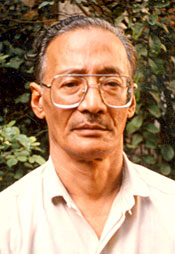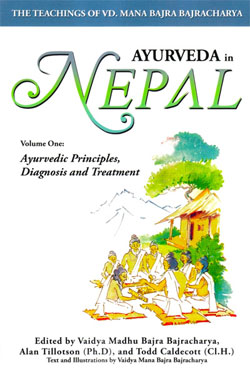Book Review:
Ayurveda in Nepal, Volume One: Ayurvedic Principles, Diagnosis and Treatment
by Vaidya Mana Bajra Bajracharya
Edited by Vaidya Madhu Bajra Bajracharya, Alan Tillotson and Todd Caldecott
Directly based on clinical manuals of a great Nepalese Ayurvedic practitioner, Dr. Mana Bajra Bajracharya, Ayurveda in Nepal goes far beyond the usual instructive or encyclopedic books that are currently available in English.
Alan Tillotson, one of the book’s editors, first met Dr. Mana when he contracted an illness while touring the region. Alan was so impressed with Dr. Mana that he returned several times to personally study with him in what was apparently the busiest Ayurvedic clinic in the region.
According to Alan, ‘This book is how Dr. Mana thinks.’ Remaining true to the spirit and exact translation of Dr Mana’s words, Alan stated that ‘I could not change it in any way.’ This in itself offers a rare insight into the inner sanctum of a great Ayurvedic vaidya, meaning ‘one who knows,’ as in ‘professor’ or ‘physician.’ Dr. Mana even provided the illustrations for the book!
After a unique overview of the tenets, theory and principles of Ayurveda, over half the book serves as a clinical manual that any practitioner of Ayurveda would appreciate owning. The one drawback is that while Ayurveda is growing in popularity in the West, it hasn’t quite reached the stage where one has easy access to the wide range of Ayurvedic herbs and preparations described in the book.
But where there is a will, there is a way; the few Ayurvedic clinicians in the West have somehow managed to find their own personal access to Ayurvedic medicines either through local sources or by importing them directly from India. Such a problem is bound to remedy itself over time and when it does, this is a book you will want to have on hand.
Despite this temporary difficulty, there remain literally hundreds of accessible preparations that could be tried, such as the following:
- narayana oil mixed with mineral salt for gum disease (p. 284)
- a list of blood purifiers (p. 253)
- pomegranate rind for blood deficiency (p. 254)
- guduchi for inflamed pittaja urine (p. 202), not to mention the descriptions of different urine qualities for diagnostic purposes
- remedies for hypertension (p. 190), including yogarajaguggul for “excess blood volume hypertension” and the use of laxatives if hypertension is also along with constipation
- three basic remedies for digestive fire (p. 155)
- triphala guggulu for anemia
- tulsi for asthma (p. 269)
- neem, tulsi, turmeric for purifying mother’s milk (this one is really good)
- neem, haritaki and vasaca for basic Pitta problems (p. 67)
- anise and omum seed for kapha (from the Indian grocery stores)
- acorus, amalaki, gokshura and shatavari for basic vata treatment instead of just ashwagandha (p. 56)
- ‘¦ and more!
Ayurveda in Nepal’s extensive index makes it easy to look up a disease and find something immediately useful for yourself, family, friends or patients. The book lists literally several thousand remedies providing convenient access to hundreds of therapeutic ideas.
 Throughout the book there is frequent mention of a number of Ayurvedic herbs and preparations now popular in the West. Of great value is the affirmative revelation to many that there are uses for some of the more popular Ayurvedic herbs and preparations beyond those that have been most commercially exploited, such as guggul for cholesterol, curcumin for inflammation and cancer, or holy basil for lowering cortisol and relieving stress. In Ayurveda in Nepal we get a rare glimpse of the traditional knowledge of these and other popular herbs and remedies together with the authority of Dr. Mana (shown at right), one of the most highly respected modern Ayurvedic doctors who uses them in these certain ways.
Throughout the book there is frequent mention of a number of Ayurvedic herbs and preparations now popular in the West. Of great value is the affirmative revelation to many that there are uses for some of the more popular Ayurvedic herbs and preparations beyond those that have been most commercially exploited, such as guggul for cholesterol, curcumin for inflammation and cancer, or holy basil for lowering cortisol and relieving stress. In Ayurveda in Nepal we get a rare glimpse of the traditional knowledge of these and other popular herbs and remedies together with the authority of Dr. Mana (shown at right), one of the most highly respected modern Ayurvedic doctors who uses them in these certain ways.
Ayurveda in Nepal is the first of an intended encyclopedic series, but you need not wait for future volumes. This first volume especially focuses on eye, ear, nose and throat ailments while including a somewhat broader range of pathologies such as childhood diseases, skin diseases and metabolic diseases.
About the editors
Alan Tillotson holds a Ph.D in Integrative Health Sciences (IUPS), and is a licensed acupuncturist in Delaware. He has extensive experience with many Asian health sciences and I’m proud to say was an early graduate of the East West School of Planetary Herbology. Alan is the author of The One Earth Herbal Source Book which reflects the eclectic approach of Planetary Herbology, integrating Western, Chinese and Ayurvedic principles, herbs and preparations. He has been in practice 21 years and is married to Naixin Hu, a scholar TCM practitioner with whom he shares a clinical practice in Delaware. Find out more about Alan and Naixin and their clinic at the Tillotson Institute of Natural Health.
Ayurveda in Nepal is coedited with Todd Caldecott (Dip. Cl.H.) who is the author of the highly respected Ayurveda: The Divine Science of Life, published by Mosby. He is a clinical herbalist and Ayurvedic practitioner with a clinic in Vancouver, B.C. Visit Todd online here.
The book also benefits from the editorial guidance of Dr. Mana’s son, Vaidya Madhu Bajra Bajracharya.
The combination of these distinguished editors for the legacy of this great Nepalese doctor makes for a creditable, in-depth book. I recommend this truly unique book to all serious practitioners and students of Ayurvedic medicine. Please check it out further at www.ayurvedainnepal.com. You can buy the book here.

